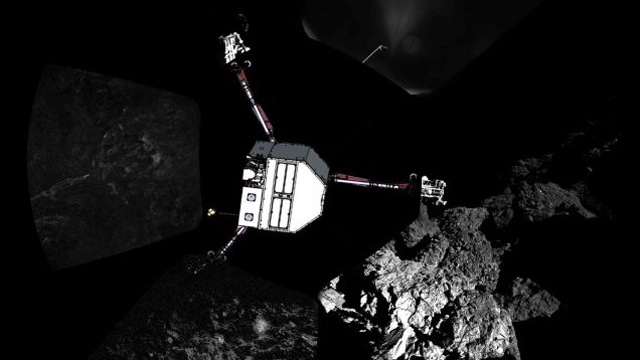It was a historic landing on a comet, but unfortunately, not a smooth one. The ESA confirmed that Rosetta’s lander, Philae, bounced twice and ultimately ended up sideways in the shadow of a cliff, where its solar panels can’t gather enough energy. When Philae’s battery dies, the mission will die with it.
For now, it’s race to gather as much scientific data as possible before the battery’s initial charge of 64 hours runs out. Philae’s investigation of the comet’s ice and rock, which is supposed to give clues to the origins of our solar system, will be severely hampered and cut short by the rocky landing.
The problem began, it seems, when Philae touched down on the comet for the first time, but its harpoons did not fire to anchor the lander. The comet’s gravity is 100,000 times weaker than Earth’s, so Philae bounced more than half a mile into space before setting down, once to bounce a second time. Now, the ESA thinks Philae is sitting on its side, with one of its three feet in the air, at the bottom of a cliff.
In this position, Philae will only get 1.5 hours of sun every 12 hours. Once its initial charge runs out, it will go dark. The lander has no way of moving around on its own, but the ESA is exploring how its drill or harpoons can be repurposed to give the machine a jolt. Philae might also become active again when it gets closer to the sun, but that’s only a distant possibility for now.
The borked landing means Philae won’t be able to use its scientific drill to take samples of the comet. (With such low gravity, drilling while unanchored could destabilise the whole lander.) The drilling system was designed to take samples up to 23cm below the comet’s surface, feeding them into ovens that vaporised them for analysis. One of Philae’s key experiments was examining hydrogen isotopes on the comet to figure how whether Earth’s water, which is composed of hydrogen and oxygen, really did come from comets crashing into the planet long ago.
Now, unless something changes, Philae will have a radically shortened amount of time to study the comet — hours instead of months. It was supposed to operate until March 2015, when it got too hot with the comet’s approach toward the sun. It is also limited to samples on the surface.
That doesn’t mean the mission was a complete failure; Philae is already sending back a ton of data and photos back to Earth. Landing on a comet after a 10 year journey through space is still a historic accomplishment. [Nature, BBC]
Picture: A sketch of Philae superimposed on its location on the comet, via ESA.
